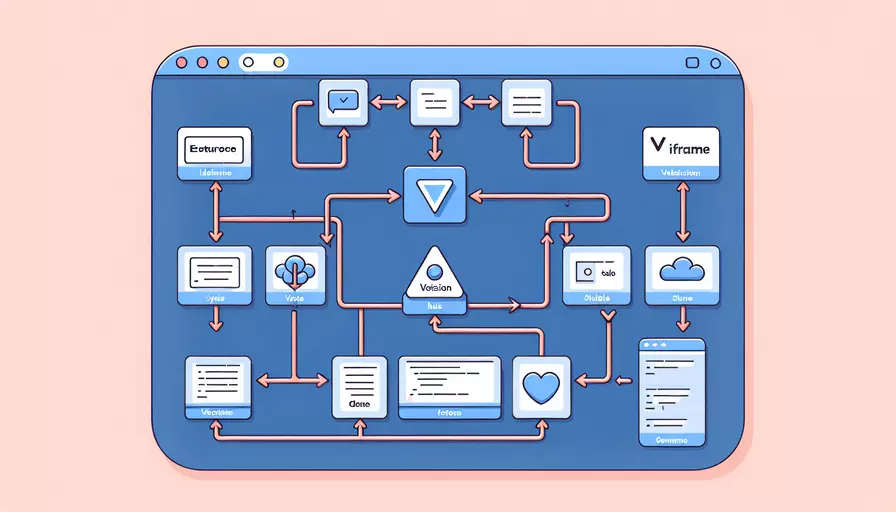
要在iframe中调用Vue函数,可以通过以下几步实现:1、使用postMessage进行通信;2、在父窗口中监听消息;3、在iframe内部发送消息。这些步骤确保了父窗口和iframe之间的安全和有效通信。下面详细描述每一步骤。
一、使用postMessage进行通信
postMessage 是一种在不同源之间安全传递消息的方法。它允许一个窗口发送消息给另一个窗口,无论它们是否同源。使用 postMessage 可以确保iframe和父窗口之间的通信安全可靠。
二、在父窗口中监听消息
- 在父窗口中创建Vue实例:确保父窗口中已经创建并初始化了Vue实例。
- 添加消息监听器:在Vue实例中添加一个监听器,用于接收来自iframe的消息。
- 处理接收到的消息:在消息监听器中,解析并处理接收到的消息,然后调用Vue实例中的相应函数。
new Vue({
el: '#app',
data: {
message: 'Hello Vue!'
},
methods: {
myVueFunction: function(data) {
console.log('Vue function called with data:', data);
// 处理数据
}
},
created() {
window.addEventListener('message', (event) => {
if (event.origin !== 'http://your-iframe-origin.com') {
return;
}
if (event.data.type === 'CALL_VUE_FUNCTION') {
this.myVueFunction(event.data.payload);
}
});
}
});
三、在iframe内部发送消息
- 获取父窗口的引用:在iframe内部,通过
window.parent获取父窗口的引用。 - 发送消息:使用
postMessage方法将消息发送到父窗口。
function callParentVueFunction(data) {
window.parent.postMessage({
type: 'CALL_VUE_FUNCTION',
payload: data
}, 'http://your-parent-origin.com');
}
四、确保安全性和正确性
为确保通信的安全性和正确性,需要注意以下几点:
- 验证消息来源:在父窗口中接收消息时,验证
event.origin以确保消息来自可信的来源。 - 结构化数据:发送和接收的数据应该是结构化的,建议使用对象格式,并包含消息类型和有效负载。
- 错误处理:在消息处理过程中,添加适当的错误处理逻辑,以应对可能的异常情况。
五、实例说明
假设有一个iframe嵌入在父窗口中,iframe中有一个按钮,点击按钮后需要调用父窗口中的Vue函数。以下是完整的实现示例:
父窗口代码(index.html):
<!DOCTYPE html>
<html>
<head>
<title>Parent Window</title>
<script src="https://cdn.jsdelivr.net/npm/vue@2"></script>
</head>
<body>
<div id="app">
<p>{{ message }}</p>
</div>
<iframe src="iframe.html" width="600" height="400"></iframe>
<script>
new Vue({
el: '#app',
data: {
message: 'Hello Vue!'
},
methods: {
myVueFunction: function(data) {
console.log('Vue function called with data:', data);
this.message = data;
}
},
created() {
window.addEventListener('message', (event) => {
if (event.origin !== 'http://your-iframe-origin.com') {
return;
}
if (event.data.type === 'CALL_VUE_FUNCTION') {
this.myVueFunction(event.data.payload);
}
});
}
});
</script>
</body>
</html>
iframe代码(iframe.html):
<!DOCTYPE html>
<html>
<head>
<title>Iframe</title>
</head>
<body>
<button onclick="callParentVueFunction('Hello from iframe!')">Call Vue Function</button>
<script>
function callParentVueFunction(data) {
window.parent.postMessage({
type: 'CALL_VUE_FUNCTION',
payload: data
}, 'http://your-parent-origin.com');
}
</script>
</body>
</html>
通过上述代码,当点击iframe中的按钮时,父窗口中的Vue函数将被调用,并更新Vue实例的数据。
六、总结与建议
通过使用 postMessage 实现iframe和父窗口的通信,可以在iframe中调用父窗口的Vue函数。主要步骤包括:1、使用postMessage进行通信;2、在父窗口中监听消息;3、在iframe内部发送消息。为了确保通信的安全性和正确性,建议验证消息来源、使用结构化数据和添加错误处理逻辑。在实际应用中,可以根据具体需求进一步扩展和优化此方案。
相关问答FAQs:
Q: 如何在iframe中调用vue函数?
A: 在iframe中调用vue函数可以通过以下几个步骤实现。
- 确保iframe和父页面都引入了Vue库。可以在父页面和iframe页面的HTML头部添加Vue库的引用。
<script src="https://cdn.jsdelivr.net/npm/vue"></script>
- 在父页面中定义一个全局的vue实例,并将其挂载到window对象上,以便在iframe中可以访问到。
var app = new Vue({
data: {
message: 'Hello, Vue!'
},
methods: {
greet: function() {
alert(this.message);
}
}
});
window.app = app;
- 在iframe页面中,可以通过
window.parent来访问到父页面的window对象,从而获取到父页面的vue实例。
var parentVue = window.parent.app;
// 调用父页面的vue函数
parentVue.greet();
通过上述步骤,你就可以在iframe中成功调用父页面的vue函数了。
注意事项:
- 确保iframe的src属性指向同源的页面,否则会出现跨域问题。
- 确保在vue函数定义之前,引入Vue库。
Q: 如何在Vue中使用iframe?
A: 在Vue中使用iframe可以通过以下步骤实现。
- 在Vue组件中使用
<iframe>标签来创建iframe元素。
<template>
<div>
<iframe src="https://example.com"></iframe>
</div>
</template>
- 可以通过设置iframe的属性来进行自定义,例如设置宽度、高度、边框等。
<iframe src="https://example.com" width="500" height="300" frameborder="0"></iframe>
- 如果需要在Vue组件中动态地改变iframe的src属性,可以使用Vue的数据绑定。
<template>
<div>
<input type="text" v-model="iframeSrc">
<iframe :src="iframeSrc"></iframe>
</div>
</template>
<script>
export default {
data() {
return {
iframeSrc: 'https://example.com'
}
}
}
</script>
通过上述步骤,你就可以在Vue中成功使用iframe了。可以根据需要自定义iframe的属性,并且通过数据绑定来动态改变iframe的src属性。
Q: 如何在vue中实现iframe与父页面的通信?
A: 在vue中实现iframe与父页面的通信可以通过以下几个步骤实现。
- 在父页面中定义一个函数,用于接收来自iframe的消息。
function receiveMessage(event) {
var message = event.data;
// 处理来自iframe的消息
console.log('Received message from iframe:', message);
}
// 监听message事件
window.addEventListener('message', receiveMessage, false);
- 在iframe页面中,通过
window.parent来获取到父页面的window对象,并调用其postMessage方法来发送消息给父页面。
var message = 'Hello, parent page!';
window.parent.postMessage(message, '*');
- 在父页面的message事件回调函数中,可以根据需要处理来自iframe的消息。
function receiveMessage(event) {
var message = event.data;
// 处理来自iframe的消息
console.log('Received message from iframe:', message);
// 向iframe发送回复消息
var replyMessage = 'Hello, iframe!';
event.source.postMessage(replyMessage, event.origin);
}
通过上述步骤,你就可以在vue中实现iframe与父页面的通信了。在父页面中监听message事件,接收来自iframe的消息,并且可以向iframe发送回复消息。
文章标题:iframe如何调用vue函数,发布者:不及物动词,转载请注明出处:https://worktile.com/kb/p/3631123

 微信扫一扫
微信扫一扫  支付宝扫一扫
支付宝扫一扫 